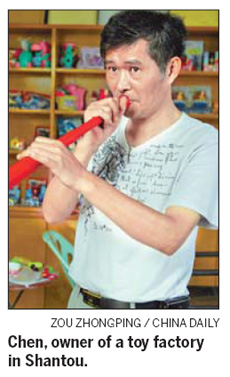InfoGraphic
Call of the VUVUZELA
By Hu Yongqi (China Daily)
Updated: 2010-06-30 11:29
 |
Large Medium Small |
 |
|
Workers at a small, privately owned factory in Ninghai county of Zhejiang province are busy making vuvuzelas, the loud trumpet popular with fans at this year's World Cup finals in South Africa. Apart from Guangdong province, Zhejiang is the other major production base for the plastic horn. [Wang Dingchang / Xinhua] |
Huang prices his vuvuzelas slightly lower than Chen at 2.5 yuan. His factory also crafts horns 6 to 10 cm long, which he sells for only 5 jiao and makes less than 1 jiao profit.
"Profit is limited but I have no choice as I have to take orders from export companies," said the Fengxiang Litong boss. "Small factories like mine have no direct connections with foreign clients, so export companies have the final word on which factory works for them."
City of delights 
With 3,000 toy plants, most of which have been open since the late 1990s, Chenghai is known as the "City of Toys".
According to Guo Zhuocai, president of the Chenghai Toy Association, the district has five factories with revenues of more than 100 million yuan and about 100 that generate more than 10 million yuan.
The association has held three trade fairs a year since 2003 but only 200 factories are qualified to take part (the minimum revenue required is 2 million yuan). A worker at one trade fair said almost 80 percent of plastic toy plants are privately-run SMEs or home-based workshops.
Sporting events like the soccer World Cup provide an excellent opportunity for Chinese manufacturers, with factories also shipping other kinds of match-day paraphernalia to South Africa.
However, such tournaments run for only short periods (the World Cup lasts just a month and will end with the title match on July 11), making a good "shrink-expand production capacity" vital for those companies looking to meet the changing demands, said factory owner Huang.
In 2008, Chen's factory had 22 staff making simple-to-assemble plastic toys. However, his business was almost destroyed when orders from foreign clients dried up during the global financial crisis.
"The crisis nearly killed the factory and me because the machines went quiet for six months and we were making no money," he said, the memory causing a deep frown.
|
||||
Chen and his family survived the crisis by making toys for Chinese retailers but had to invest 20,000 yuan to stay afloat. The question now is whether the popularity of the vuvuzela will be enough to sustain production.
Due to the horns' arguably offensive drone, several sporting venues have already banned fans from taking them to matches, including the ongoing Wimbledon tennis championship in London. However, Chen is already making plans to update his machines for the next opportunity to push the vuvuzela - the 2010 Asian Games in Guangzhou in November. Members of the event's organizing committee on Monday told China Daily the horns will be allowed.
"As vuvuzelas get more popular around the world, I am pretty sure domestic fans will be interested in the little horns," said an excited Chen.




